FAS001 UTS: Understanding Australia and Asia in the Modern Era
VerifiedAdded on 2023/06/11
|7
|1323
|228
Project
AI Summary
This project provides an overview of the historical and contemporary relationship between Australia and Asia, tracing the evolution of diplomatic ties from the Colombo Plan era to the present-day challenges of the Asian Century. It highlights key initiatives, such as the Bogor Declaration and Australia's military expertise training programs, while also addressing contemporary issues like Australia's economic dependence on Asia and internal debates regarding its engagement policies. The project reflects on the cultural and economic ties fostered by these relationships, the potential disruptions posed by the Asian Century, and Australia's efforts to maintain its regional standing through strategic planning and diversification. Ultimately, it emphasizes the enduring need for cooperation and balanced relations between Australia and Asian countries, given Australia's reliance on the region for its economic and social well-being. Desklib offers a wealth of resources, including similar projects and past papers, to aid students in their studies.
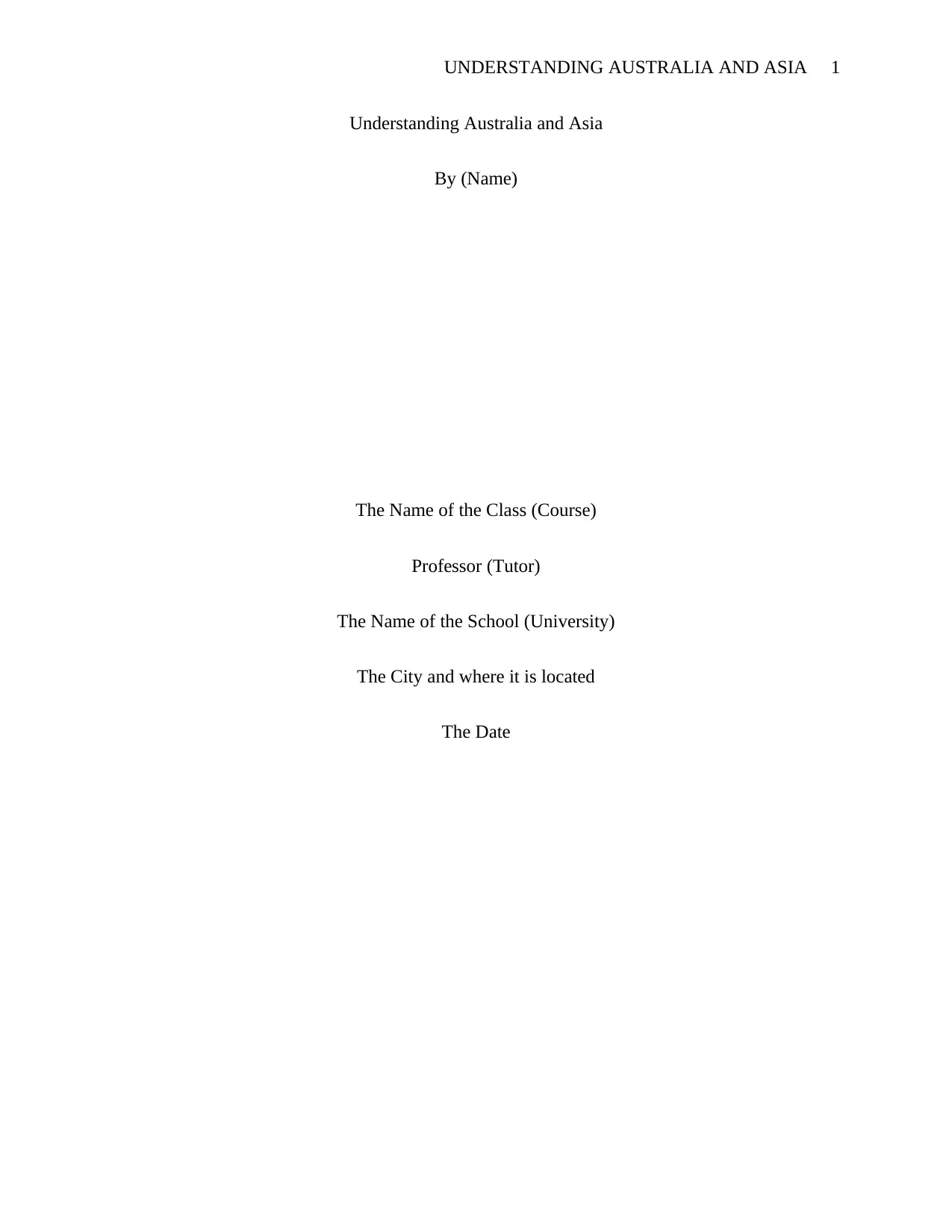
UNDERSTANDING AUSTRALIA AND ASIA 1
Understanding Australia and Asia
By (Name)
The Name of the Class (Course)
Professor (Tutor)
The Name of the School (University)
The City and where it is located
The Date
Understanding Australia and Asia
By (Name)
The Name of the Class (Course)
Professor (Tutor)
The Name of the School (University)
The City and where it is located
The Date
Paraphrase This Document
Need a fresh take? Get an instant paraphrase of this document with our AI Paraphraser
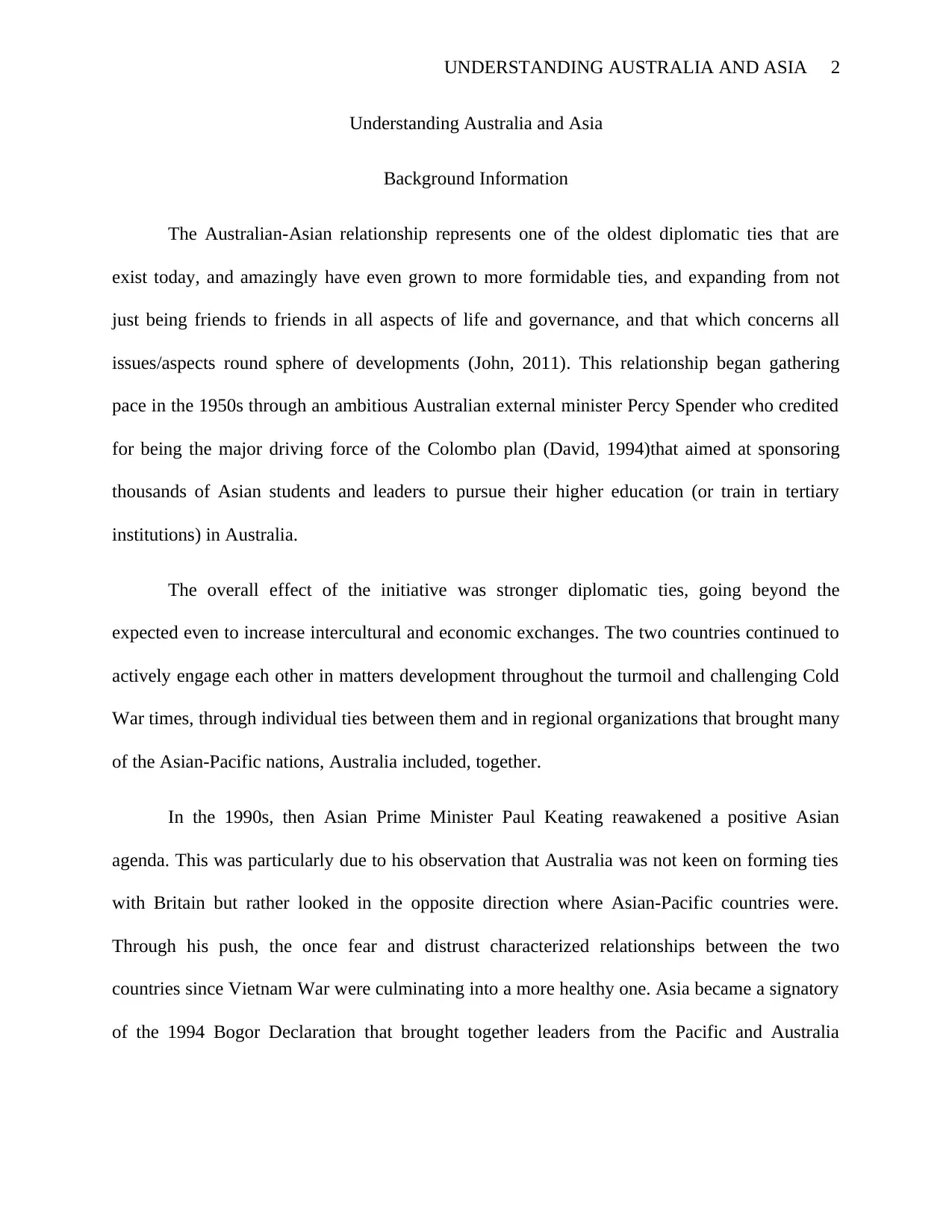
UNDERSTANDING AUSTRALIA AND ASIA 2
Understanding Australia and Asia
Background Information
The Australian-Asian relationship represents one of the oldest diplomatic ties that are
exist today, and amazingly have even grown to more formidable ties, and expanding from not
just being friends to friends in all aspects of life and governance, and that which concerns all
issues/aspects round sphere of developments (John, 2011). This relationship began gathering
pace in the 1950s through an ambitious Australian external minister Percy Spender who credited
for being the major driving force of the Colombo plan (David, 1994)that aimed at sponsoring
thousands of Asian students and leaders to pursue their higher education (or train in tertiary
institutions) in Australia.
The overall effect of the initiative was stronger diplomatic ties, going beyond the
expected even to increase intercultural and economic exchanges. The two countries continued to
actively engage each other in matters development throughout the turmoil and challenging Cold
War times, through individual ties between them and in regional organizations that brought many
of the Asian-Pacific nations, Australia included, together.
In the 1990s, then Asian Prime Minister Paul Keating reawakened a positive Asian
agenda. This was particularly due to his observation that Australia was not keen on forming ties
with Britain but rather looked in the opposite direction where Asian-Pacific countries were.
Through his push, the once fear and distrust characterized relationships between the two
countries since Vietnam War were culminating into a more healthy one. Asia became a signatory
of the 1994 Bogor Declaration that brought together leaders from the Pacific and Australia
Understanding Australia and Asia
Background Information
The Australian-Asian relationship represents one of the oldest diplomatic ties that are
exist today, and amazingly have even grown to more formidable ties, and expanding from not
just being friends to friends in all aspects of life and governance, and that which concerns all
issues/aspects round sphere of developments (John, 2011). This relationship began gathering
pace in the 1950s through an ambitious Australian external minister Percy Spender who credited
for being the major driving force of the Colombo plan (David, 1994)that aimed at sponsoring
thousands of Asian students and leaders to pursue their higher education (or train in tertiary
institutions) in Australia.
The overall effect of the initiative was stronger diplomatic ties, going beyond the
expected even to increase intercultural and economic exchanges. The two countries continued to
actively engage each other in matters development throughout the turmoil and challenging Cold
War times, through individual ties between them and in regional organizations that brought many
of the Asian-Pacific nations, Australia included, together.
In the 1990s, then Asian Prime Minister Paul Keating reawakened a positive Asian
agenda. This was particularly due to his observation that Australia was not keen on forming ties
with Britain but rather looked in the opposite direction where Asian-Pacific countries were.
Through his push, the once fear and distrust characterized relationships between the two
countries since Vietnam War were culminating into a more healthy one. Asia became a signatory
of the 1994 Bogor Declaration that brought together leaders from the Pacific and Australia
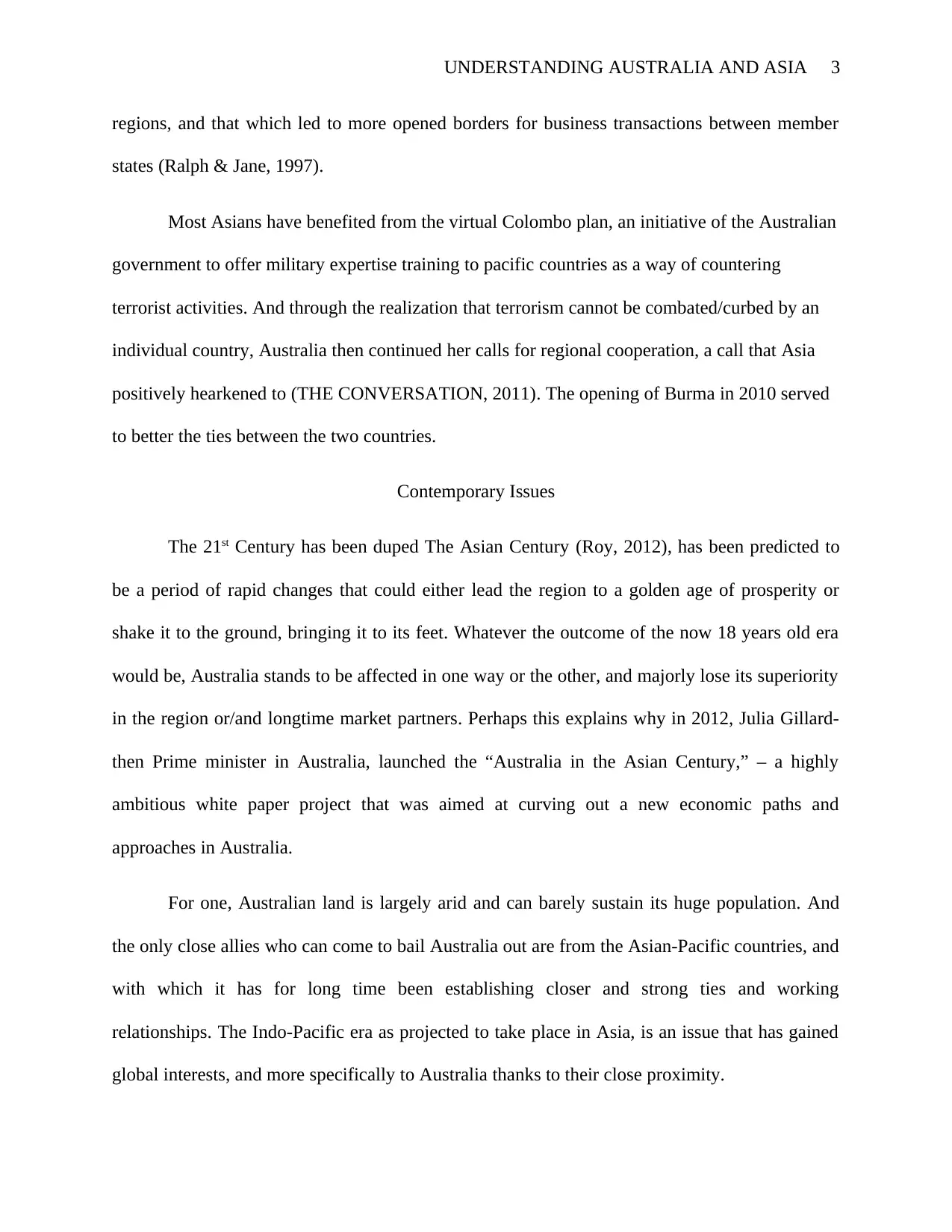
UNDERSTANDING AUSTRALIA AND ASIA 3
regions, and that which led to more opened borders for business transactions between member
states (Ralph & Jane, 1997).
Most Asians have benefited from the virtual Colombo plan, an initiative of the Australian
government to offer military expertise training to pacific countries as a way of countering
terrorist activities. And through the realization that terrorism cannot be combated/curbed by an
individual country, Australia then continued her calls for regional cooperation, a call that Asia
positively hearkened to (THE CONVERSATION, 2011). The opening of Burma in 2010 served
to better the ties between the two countries.
Contemporary Issues
The 21st Century has been duped The Asian Century (Roy, 2012), has been predicted to
be a period of rapid changes that could either lead the region to a golden age of prosperity or
shake it to the ground, bringing it to its feet. Whatever the outcome of the now 18 years old era
would be, Australia stands to be affected in one way or the other, and majorly lose its superiority
in the region or/and longtime market partners. Perhaps this explains why in 2012, Julia Gillard-
then Prime minister in Australia, launched the “Australia in the Asian Century,” – a highly
ambitious white paper project that was aimed at curving out a new economic paths and
approaches in Australia.
For one, Australian land is largely arid and can barely sustain its huge population. And
the only close allies who can come to bail Australia out are from the Asian-Pacific countries, and
with which it has for long time been establishing closer and strong ties and working
relationships. The Indo-Pacific era as projected to take place in Asia, is an issue that has gained
global interests, and more specifically to Australia thanks to their close proximity.
regions, and that which led to more opened borders for business transactions between member
states (Ralph & Jane, 1997).
Most Asians have benefited from the virtual Colombo plan, an initiative of the Australian
government to offer military expertise training to pacific countries as a way of countering
terrorist activities. And through the realization that terrorism cannot be combated/curbed by an
individual country, Australia then continued her calls for regional cooperation, a call that Asia
positively hearkened to (THE CONVERSATION, 2011). The opening of Burma in 2010 served
to better the ties between the two countries.
Contemporary Issues
The 21st Century has been duped The Asian Century (Roy, 2012), has been predicted to
be a period of rapid changes that could either lead the region to a golden age of prosperity or
shake it to the ground, bringing it to its feet. Whatever the outcome of the now 18 years old era
would be, Australia stands to be affected in one way or the other, and majorly lose its superiority
in the region or/and longtime market partners. Perhaps this explains why in 2012, Julia Gillard-
then Prime minister in Australia, launched the “Australia in the Asian Century,” – a highly
ambitious white paper project that was aimed at curving out a new economic paths and
approaches in Australia.
For one, Australian land is largely arid and can barely sustain its huge population. And
the only close allies who can come to bail Australia out are from the Asian-Pacific countries, and
with which it has for long time been establishing closer and strong ties and working
relationships. The Indo-Pacific era as projected to take place in Asia, is an issue that has gained
global interests, and more specifically to Australia thanks to their close proximity.
⊘ This is a preview!⊘
Do you want full access?
Subscribe today to unlock all pages.

Trusted by 1+ million students worldwide
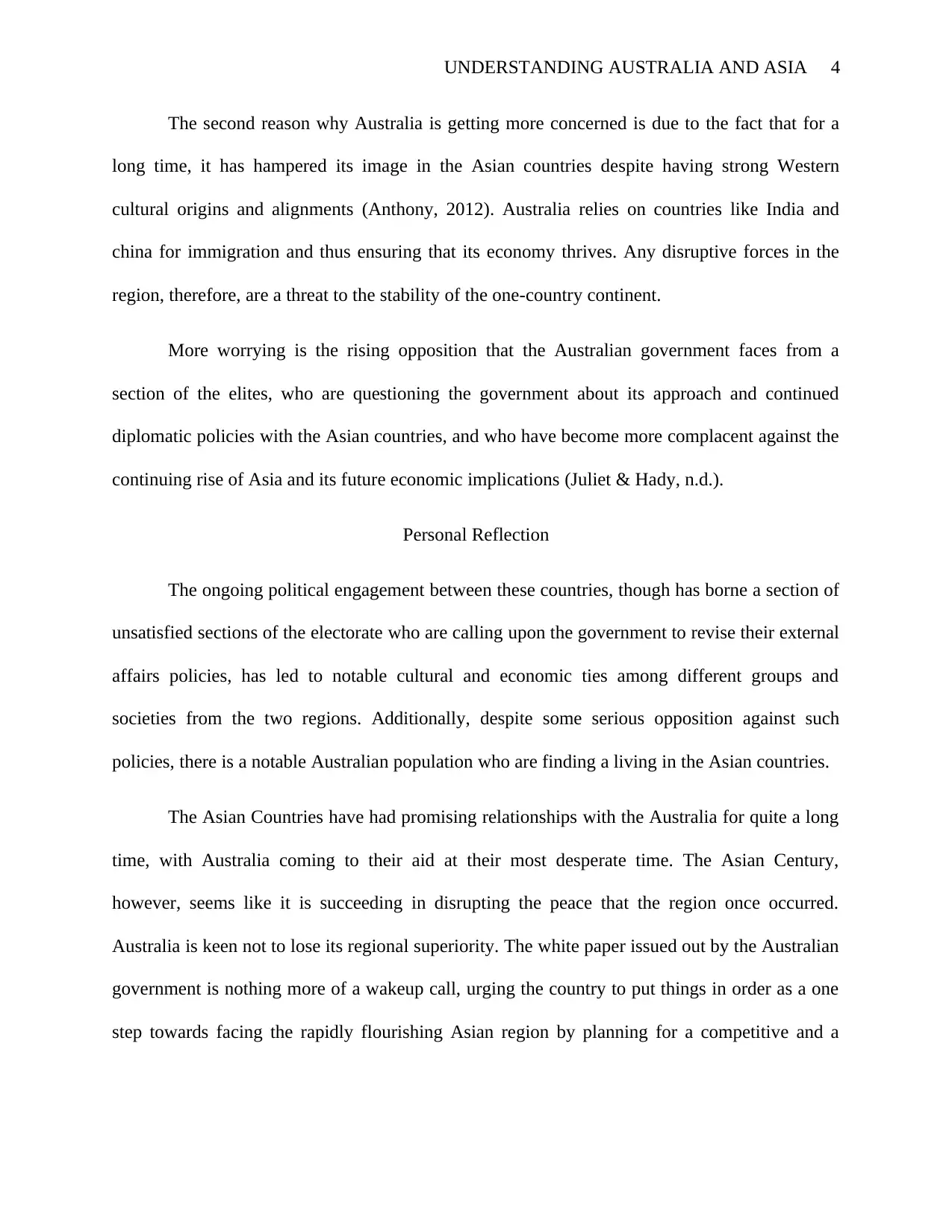
UNDERSTANDING AUSTRALIA AND ASIA 4
The second reason why Australia is getting more concerned is due to the fact that for a
long time, it has hampered its image in the Asian countries despite having strong Western
cultural origins and alignments (Anthony, 2012). Australia relies on countries like India and
china for immigration and thus ensuring that its economy thrives. Any disruptive forces in the
region, therefore, are a threat to the stability of the one-country continent.
More worrying is the rising opposition that the Australian government faces from a
section of the elites, who are questioning the government about its approach and continued
diplomatic policies with the Asian countries, and who have become more complacent against the
continuing rise of Asia and its future economic implications (Juliet & Hady, n.d.).
Personal Reflection
The ongoing political engagement between these countries, though has borne a section of
unsatisfied sections of the electorate who are calling upon the government to revise their external
affairs policies, has led to notable cultural and economic ties among different groups and
societies from the two regions. Additionally, despite some serious opposition against such
policies, there is a notable Australian population who are finding a living in the Asian countries.
The Asian Countries have had promising relationships with the Australia for quite a long
time, with Australia coming to their aid at their most desperate time. The Asian Century,
however, seems like it is succeeding in disrupting the peace that the region once occurred.
Australia is keen not to lose its regional superiority. The white paper issued out by the Australian
government is nothing more of a wakeup call, urging the country to put things in order as a one
step towards facing the rapidly flourishing Asian region by planning for a competitive and a
The second reason why Australia is getting more concerned is due to the fact that for a
long time, it has hampered its image in the Asian countries despite having strong Western
cultural origins and alignments (Anthony, 2012). Australia relies on countries like India and
china for immigration and thus ensuring that its economy thrives. Any disruptive forces in the
region, therefore, are a threat to the stability of the one-country continent.
More worrying is the rising opposition that the Australian government faces from a
section of the elites, who are questioning the government about its approach and continued
diplomatic policies with the Asian countries, and who have become more complacent against the
continuing rise of Asia and its future economic implications (Juliet & Hady, n.d.).
Personal Reflection
The ongoing political engagement between these countries, though has borne a section of
unsatisfied sections of the electorate who are calling upon the government to revise their external
affairs policies, has led to notable cultural and economic ties among different groups and
societies from the two regions. Additionally, despite some serious opposition against such
policies, there is a notable Australian population who are finding a living in the Asian countries.
The Asian Countries have had promising relationships with the Australia for quite a long
time, with Australia coming to their aid at their most desperate time. The Asian Century,
however, seems like it is succeeding in disrupting the peace that the region once occurred.
Australia is keen not to lose its regional superiority. The white paper issued out by the Australian
government is nothing more of a wakeup call, urging the country to put things in order as a one
step towards facing the rapidly flourishing Asian region by planning for a competitive and a
Paraphrase This Document
Need a fresh take? Get an instant paraphrase of this document with our AI Paraphraser
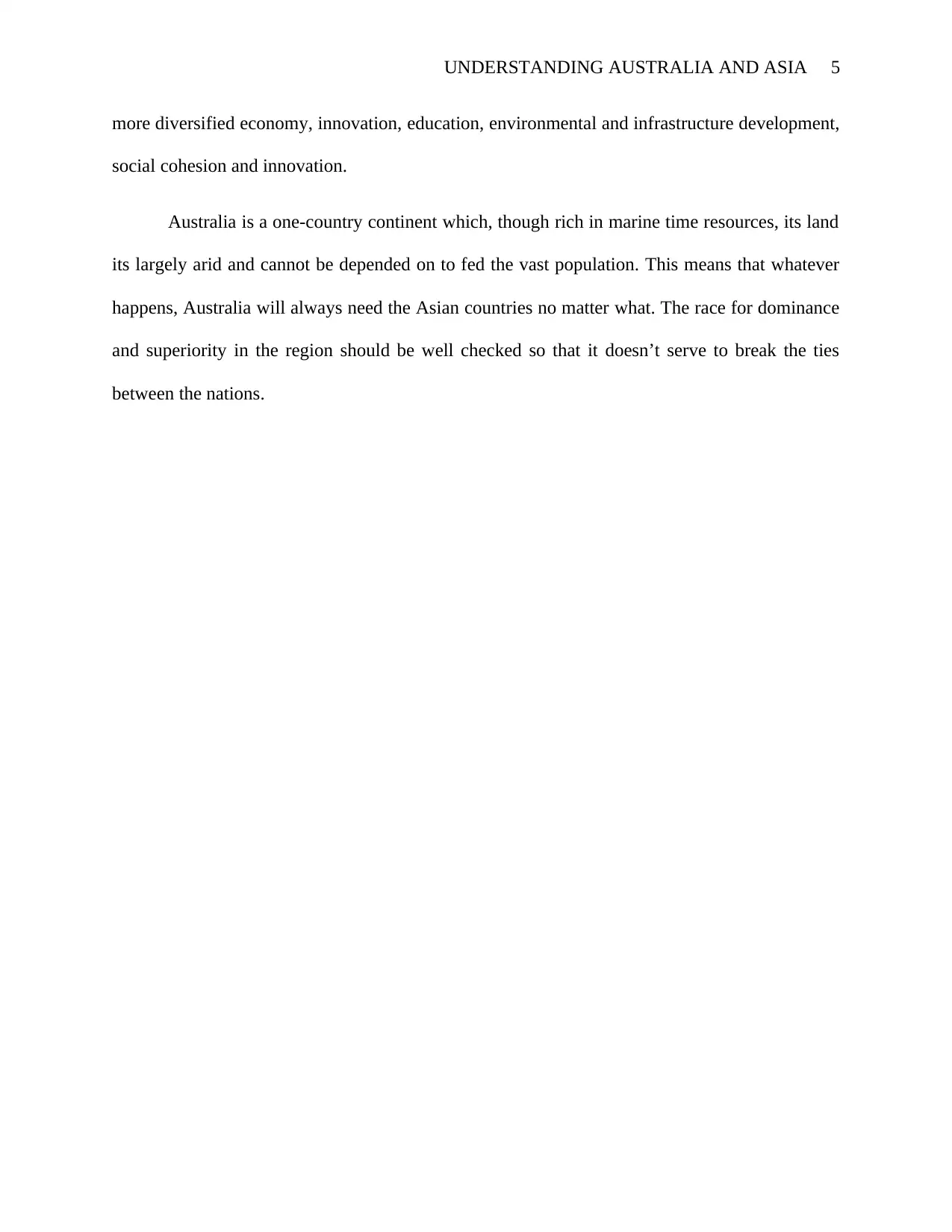
UNDERSTANDING AUSTRALIA AND ASIA 5
more diversified economy, innovation, education, environmental and infrastructure development,
social cohesion and innovation.
Australia is a one-country continent which, though rich in marine time resources, its land
its largely arid and cannot be depended on to fed the vast population. This means that whatever
happens, Australia will always need the Asian countries no matter what. The race for dominance
and superiority in the region should be well checked so that it doesn’t serve to break the ties
between the nations.
more diversified economy, innovation, education, environmental and infrastructure development,
social cohesion and innovation.
Australia is a one-country continent which, though rich in marine time resources, its land
its largely arid and cannot be depended on to fed the vast population. This means that whatever
happens, Australia will always need the Asian countries no matter what. The race for dominance
and superiority in the region should be well checked so that it doesn’t serve to break the ties
between the nations.
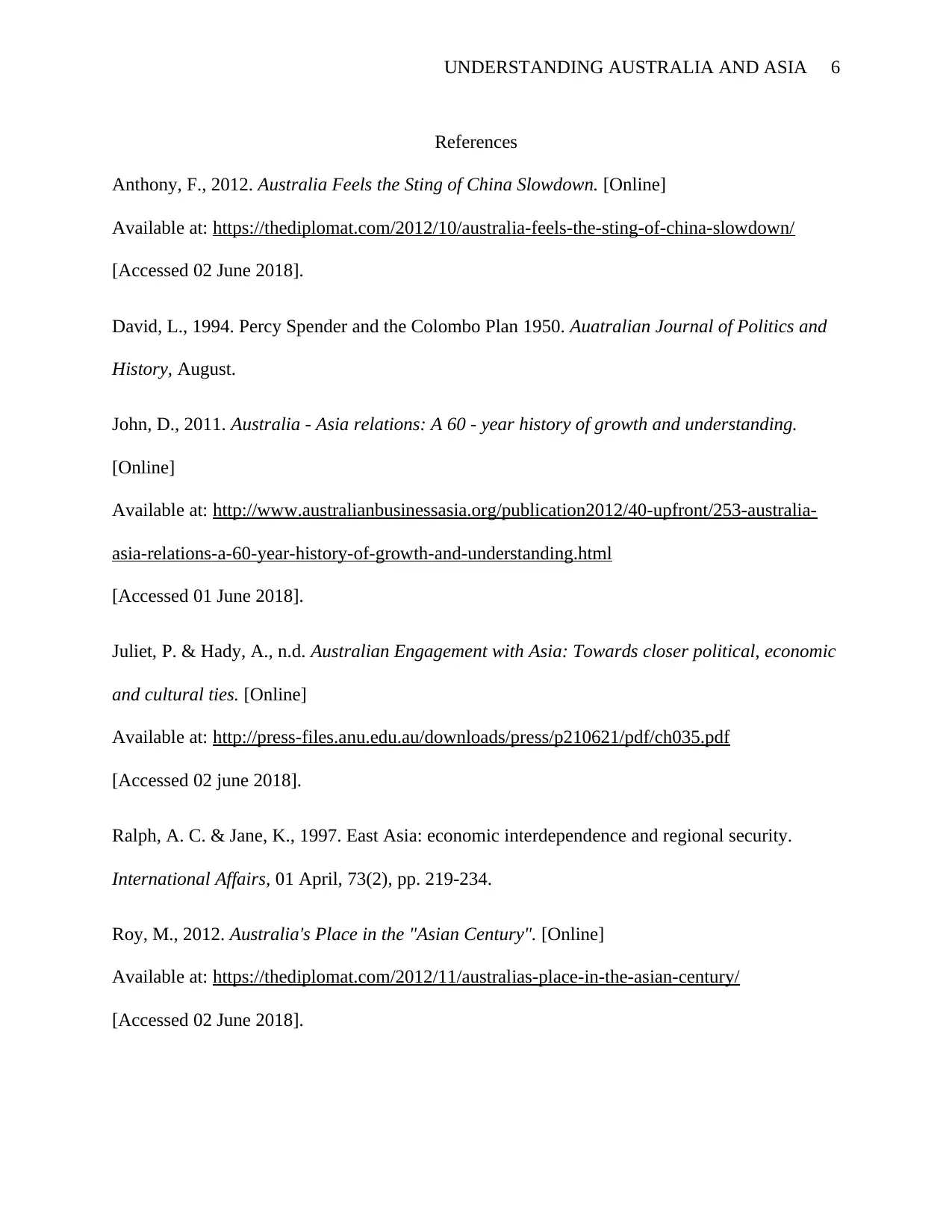
UNDERSTANDING AUSTRALIA AND ASIA 6
References
Anthony, F., 2012. Australia Feels the Sting of China Slowdown. [Online]
Available at: https://thediplomat.com/2012/10/australia-feels-the-sting-of-china-slowdown/
[Accessed 02 June 2018].
David, L., 1994. Percy Spender and the Colombo Plan 1950. Auatralian Journal of Politics and
History, August.
John, D., 2011. Australia - Asia relations: A 60 - year history of growth and understanding.
[Online]
Available at: http://www.australianbusinessasia.org/publication2012/40-upfront/253-australia-
asia-relations-a-60-year-history-of-growth-and-understanding.html
[Accessed 01 June 2018].
Juliet, P. & Hady, A., n.d. Australian Engagement with Asia: Towards closer political, economic
and cultural ties. [Online]
Available at: http://press-files.anu.edu.au/downloads/press/p210621/pdf/ch035.pdf
[Accessed 02 june 2018].
Ralph, A. C. & Jane, K., 1997. East Asia: economic interdependence and regional security.
International Affairs, 01 April, 73(2), pp. 219-234.
Roy, M., 2012. Australia's Place in the "Asian Century". [Online]
Available at: https://thediplomat.com/2012/11/australias-place-in-the-asian-century/
[Accessed 02 June 2018].
References
Anthony, F., 2012. Australia Feels the Sting of China Slowdown. [Online]
Available at: https://thediplomat.com/2012/10/australia-feels-the-sting-of-china-slowdown/
[Accessed 02 June 2018].
David, L., 1994. Percy Spender and the Colombo Plan 1950. Auatralian Journal of Politics and
History, August.
John, D., 2011. Australia - Asia relations: A 60 - year history of growth and understanding.
[Online]
Available at: http://www.australianbusinessasia.org/publication2012/40-upfront/253-australia-
asia-relations-a-60-year-history-of-growth-and-understanding.html
[Accessed 01 June 2018].
Juliet, P. & Hady, A., n.d. Australian Engagement with Asia: Towards closer political, economic
and cultural ties. [Online]
Available at: http://press-files.anu.edu.au/downloads/press/p210621/pdf/ch035.pdf
[Accessed 02 june 2018].
Ralph, A. C. & Jane, K., 1997. East Asia: economic interdependence and regional security.
International Affairs, 01 April, 73(2), pp. 219-234.
Roy, M., 2012. Australia's Place in the "Asian Century". [Online]
Available at: https://thediplomat.com/2012/11/australias-place-in-the-asian-century/
[Accessed 02 June 2018].
⊘ This is a preview!⊘
Do you want full access?
Subscribe today to unlock all pages.

Trusted by 1+ million students worldwide
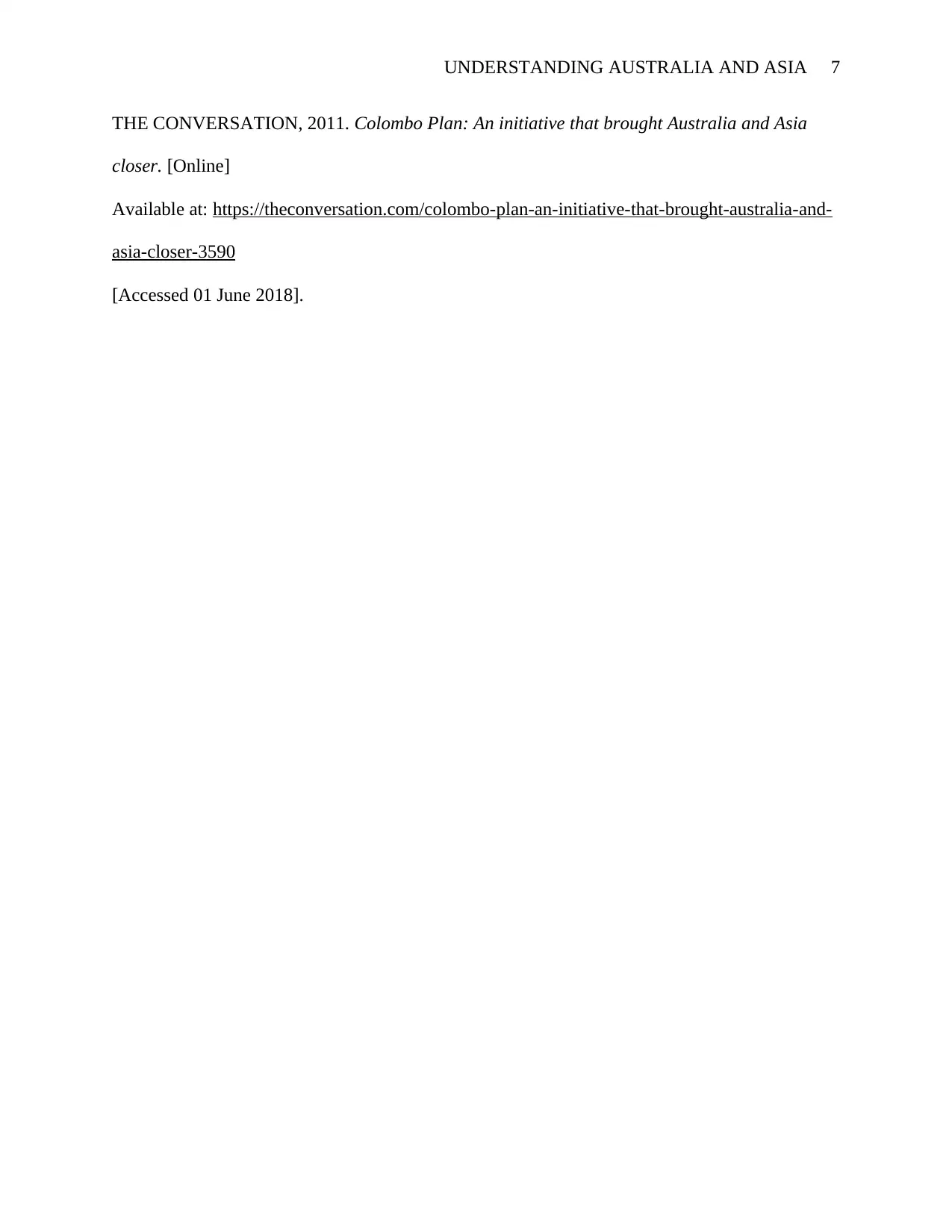
UNDERSTANDING AUSTRALIA AND ASIA 7
THE CONVERSATION, 2011. Colombo Plan: An initiative that brought Australia and Asia
closer. [Online]
Available at: https://theconversation.com/colombo-plan-an-initiative-that-brought-australia-and-
asia-closer-3590
[Accessed 01 June 2018].
THE CONVERSATION, 2011. Colombo Plan: An initiative that brought Australia and Asia
closer. [Online]
Available at: https://theconversation.com/colombo-plan-an-initiative-that-brought-australia-and-
asia-closer-3590
[Accessed 01 June 2018].
1 out of 7
Related Documents
Your All-in-One AI-Powered Toolkit for Academic Success.
+13062052269
info@desklib.com
Available 24*7 on WhatsApp / Email
![[object Object]](/_next/static/media/star-bottom.7253800d.svg)
Unlock your academic potential
Copyright © 2020–2025 A2Z Services. All Rights Reserved. Developed and managed by ZUCOL.





